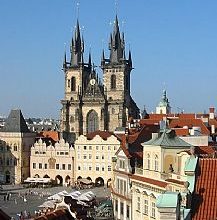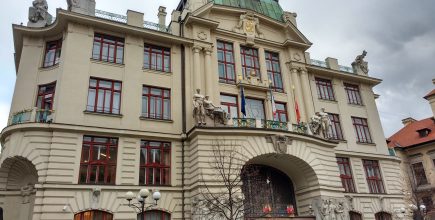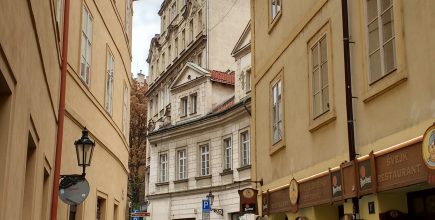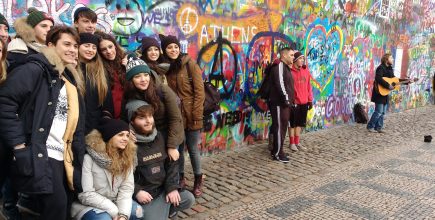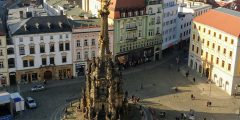Getting there
Elite city Prague is renowned for its picture postcard views, fine old buildings, a magnificent medieval clock, abundant beer and tasty dumplings.
Prague is one of Europe’s elite cities, with more knock-out picture postcard views than some entire countries. The Czech Republic capital can also get a little bit busy. But it is still possible to enjoy this hugely popular city, its traditional sights as well as the bright new attractions, while dodging the crowds.
The authorities are now encouraging visitors to explore greater Prague, beyond the tight, small Old Town along the River Vltava.
The tourist authority has published Prague Walks, to promote other neighbourhoods of historic interest, such as Vinohrady, Karlín, Holešovice and Žižkov.
Most people will arrive here by plane, with a wide range of budget flights available from UK airports. But the train is an option too. And not just all the way from the UK. It’s a possible add-on to a visit to its cultural soulmate Vienna.
London to Prague by train.
An evening departure from London and an overnight stop in Brussels. (Westbound leave Prague on an early train and you can make it to London the same day.)
Day 1, London to Brussels on any evening Eurostar. Stay overnight in Brussels. Day 2, travel from Brussels to Prague. Czech Railways – www.cd.cz. Travel via Cheb. Leave Brussels Midi at 08:20, arrive Prague Hlavni 19:17. I’m indebted to the Man in Seat 61 for this information.
02 What to see and do
Spirit of music
The music starts the moment the budget aeroplane seatbelt signs turn off. It’s Smetana’s Ma Vlast (My Country) – everybody’s favourite patriotic tune from a land other than their own. We all like going home, but hankie makers must grow rich meeting the demand among returning exiles at Prague airport with this music playing.
Music means so much to the Czechs. The Soviet thought police told Russian composers what to write, and banned pop music. But they never quite managed to snuff out the spirit of music in the then Czechoslovakia, which they controlled for 44 years until 1989.
In Prague jazz continued to bloom. On my visit the saints were proudly marching in under the solemn statues on the Charles Bridge, led by a grizzled old trooper from the generation who kept the feet tapping in the dark old days. (There must be more open air music on this bridge, summer and winter, than in any other capital in Europe.)
Grand design
Prague is listed as one of Europe’s most beautiful cities by UNESCO, the UN’s cultural agency. Emperor Charles IV founded the New Town in 1348 with the grandest of designs, to build the “New Jerusalem”. Architects followed his dream down the centuries. There’s so much for the first (or 101st) time visitor to see. Linking it all is the C15th Charles Bridge, the great pedestrian crossing of the Vltava. Prague Castle towers above the city. There are fine houses, churches and palaces everywhere you look. The crowning baroque glory, St Nicholas Church, built in 1735, towers above Old Town Square. Close by is the medieval astronomical clock. Arrive early for the elaborate parade of apostles as the clock strikes the hour.
Love is all you need
In tyrannical countries, walls usually signify loss of liberty. The John Lennon Wall was, and still is, a remarkable exception. Since 1980 the youth of Prague, and beyond, have expressed their dream for a better world in the form of quotations and creative graffiti on the wall in Grand Priory Square. Lennon never saw Prague, but soon after his assassination students began to invoke the great singer and songwriter’s spirit with defiant daubings. The all-controlling state erased their work daily, but there were always new ones next day. The tradition survived communism’s fall in 1989. On my visit the wall was as full of rousing calls to peace and harmony as ever. A busker was belting out “Love is all you need.
Shock of the new
The works of provocative and often irreverent sculptor David Černý. pop up everywhere. His model of Sigmund Freud casually hangs with one hand from a high beam jutting from a building in Husova St. In the Lucerna Palace mall, St Wenceslas rides an upside down horse, poking fun at the original statue in Wenceslas Square. Bronze babies crawl outside Museum Kampa, a grounded version of similar infants scaling the Žižkov Television Tower. (Worth a visit itself). Two male statues relieve themselves into a pond in the shape of the Czech Republic outside the museum to the writer Kakfa. Černý’s latest opus (2014), at the Quadrio shopping centre, is a 30 ft high mechanical statue of Kakfa’s head composed of 42 constantly shifting cross sections.
Fine Art
In addition to its glittering centuries-old buildings, Prague has another claim to architectural fame. Some of the finest creations of the colourful and decorative Art Nouveau (AN) movement, from the early years of the 20th century, are found in the city. Its characteristic elegant, flowing curves pop up, for example, on the outside of buildings, as in the ginkgo branches carved on the façade of Hotel Central. Those sensuous AN details are on balconies and frescoes, in bars and restaurants, and in the main train station. The exquisite stained glass window of St. Vitus Cathedral is the work of Czech artist Alphonse Mucha, one of the movement’s leading figures. Some of the most striking and sumptuous interior design inspired by the movement is in the Grand Hotel Europa’s restaurant.
Hearty fare
Let’s hear it for the humble knedliky, the Czech dumpling, ancient staple of the national cuisine made with bread or potato. They serve it with roast duck on braised red cabbage, and any of the standard pork or beef dishes dished up with a tasty sauce. Look for this hearty fare – there’s usually a garlic or mushroom soup to start – in big old rambling restaurants such as U Sandlu, off the main tourist beat. They served me a foaming pint of house beer without even asking. I found the same respect for good old home cooking in CottoCrudo , a new Italian restaurant offering the classics from the Piedmont and Tuscany regions, with a modern twist. They offer 25 different wines in manageable half-litre decanters. www.cottocrudo.com
Don Giovanni was here
Flashback to 1787 when Mozart gave the world premier of Don Giovanni here in the Stavovske Theatre. The then Bohemians took instantly to this masterpiece, while Mozart knew his native Vienna would have been aloof and disapproving.
Don Giovanni is Prague’s top claim to cultural fame, and they celebrate it daily in a reduced version played by puppets. It’s not tourist kitsch. A fine recording, excellent sound, six hard working puppeteers, comic (I loved the puppet cat hissing at an anguished diva in mid aria) and ribald (some of the Don’s conquests are, well, energetic). What a way to discover a masterpiece.
Mozart was the greatest of Prague musicians – he penned the Prague Symphony in its honour. I took the number 7 tram to his museum, in Villa Bertramka. He finished Don Giovanni in this quiet retreat under a hill. The first billboard for the opera is on display.
Mozart’s wind serenade was playing. In the film Amadeus, Salieri hears this and realises his exuberant rival has a talent way up in the stars. I find a lock of his hair on display. What a race of super-composers a mad scientist might create from the DNA.
On Charles Bridge a versatile violinist was playing Mozart’s Elvira Madigan piano concerto. I browsed among the T shirts in a shop.
There was an Amadeus T shirt, but no Dvorak. Maybe he is already close enough to Czech hearts. I turned to go. ‘Nothing you like here?’ said the assistant ‘We have Cliff Richard. Wait, I do you a discount.’
Music's New World
Music should give Prague a firmer foundation for its tourism. The city can seem like a chocolate box, richly wrapped but only one layer deep. Hardly surprising when you consider it has only existed since the 1990s as a visitor attraction. Antonin Dvorak, passionate Czech, synthesised the heart and soul of his beloved homeland in notes. Radio Prague’s signature tune is the horn fanfare from the New World Symphony.
Dvorak wrote for the world – and beyond it. He spent three years in New York, living on East 17th Street, as director of the National Conservatory. Aficionados can follow his trail there and on to Spillville Iowa, a Czech town where he played the organ, his heart aching for Bohemia. The American stay inspired the New World Symphony. US astronaut Buzz Aldrin played it during the first Moon landing.
Dvorak references abound in Prague. His statue is outside the Rudolfinum concert hall on Jan Palach Square. They performed his mass Stabat Mater, with Czechoslovakia finally free, at the inauguration of President Havel at St Vitus Cathedral high above the city.
They were playing the composer’s American Quartet as I walked around his museum in the Villa Amerika. I liked the random items on display. His gown from Cambridge when they gave him an honorary doctorate. A poster for an Albert Hall performance. And his ticket for that emotion-packed return from America.
Dvorak’s birthplace is in the little village of Nelahozeves on the Moldau, a 30 minute drive north. Dvorak senior ran the pub, now a museum devoted to the composer. Father wanted son to take over the business. Antonin could have become the most musical publican in history, or a drink-sozzled host never realising his talent.
The pile of records and CDs by the artistes of the world suggest music was the right career choice decision. On display is the first recording of the New World, a box of 10 78 rpm discs. And a letter from NASA confirming its first performance in space.
Was Dvorak the first train-spotting musician?. His love of steam engines began when the railway from Prague reached his village. (His other big love was pigeons.)
Vltava - river set to music
Smetana, (he also wrote the Bartered Bride), has the best museum spot, on the banks of the Vltava, the river of his Ma Vlast.
03 Where to stay
Key rooms
When I first visited Prague in the 1990s, hotels were standard Soviet-era issue, big and dull. How things have changed. I sampled one of the city’s new generation of smart, small and distinctive boutique hotels, woven into the city’s ancient fabric. The Golden Key opened in 2014 in a C13th building which used to be a locksmiths, set discreetly off Nerudova St, a steep cobbled route to the castle. I liked the glass roof over the lobby, and links with the past such as the uncovered C16th painted wooden ceilings, old wood floors and a piece of 200 year old original furniture in every room. The hotel’s pretty little cafe, open to the public, serves homemade cup cakes and fruit cakes from local recipes.
04 Nearby
City in the Czech Republic, one of Europe’s top ten most beautiful hidden treasures according to Lonely Planet
I came across Olomouc, unexpectedly. The Czech Republic city, one of Europe’s top ten most beautiful hidden treasures according to Lonely Planet, is name-checked no fewer than 22 times in War and Peace. “Olmutz is a very decent town“, says the diplomat Bilibin to Prince Andrei Bolkonski. “You and I will travel comfortably in my caleche.”
The Austrian Court and Russian Army were retreating there after Napoleon’s success at Ulm on the Danube. They were pulling back from Brunn, modern day Bruno.
Today this small Moravian city boasts high elegance, deep history and architectural treasures to match Prague’s (two hours away by road or rail), but without the crowds. It has palaces, fine old churches and townhouses. Its attractions include a smelly local cheese and a very political clock.

